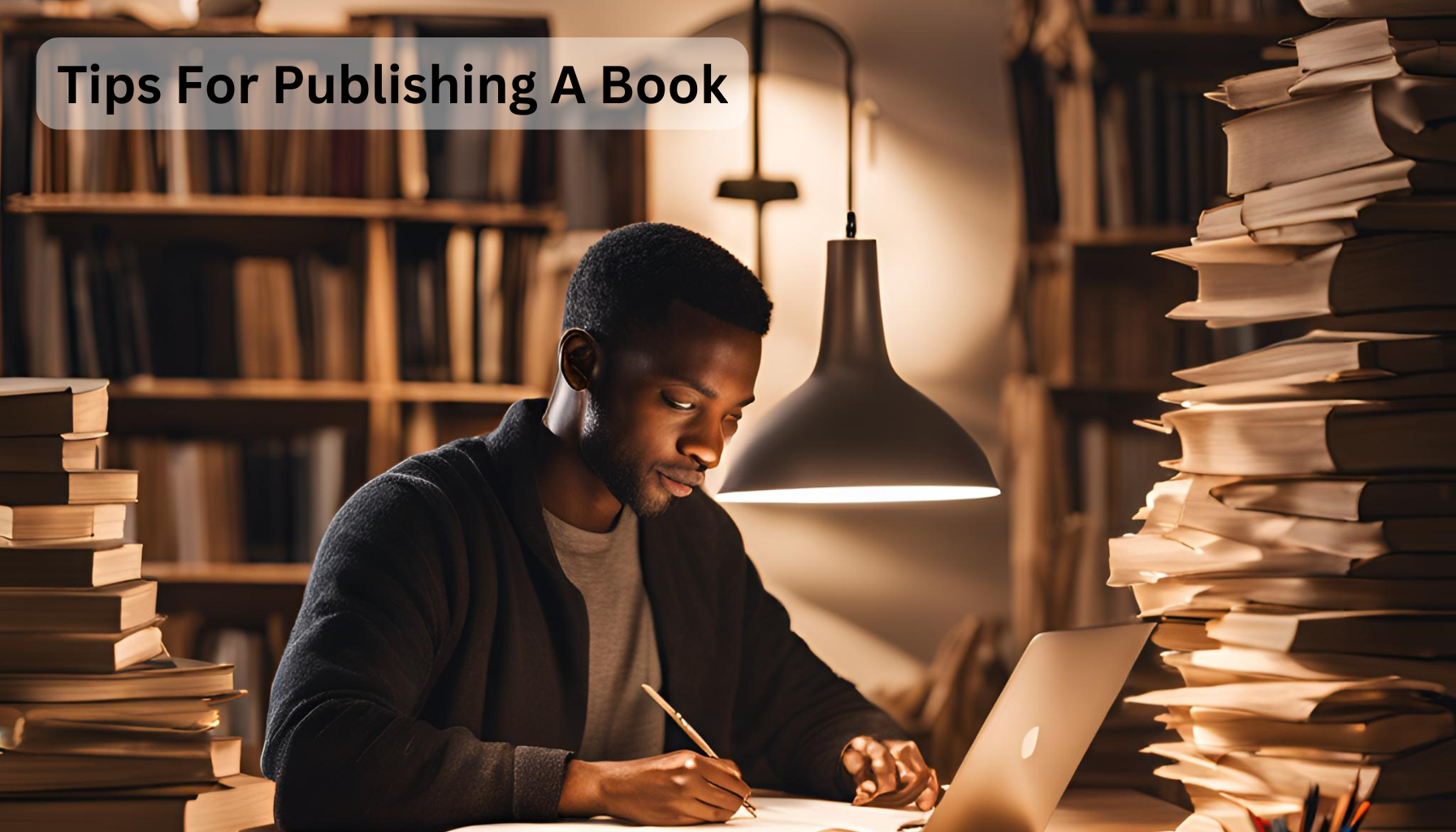Tips For Publishing A Book

Knowing How To Publish A Book…Starts Here!
Our simple guide to publishing your book, we hope you like it.
Finally finishing writing your book is a huge accomplishment, but it’s only part of the process.
Once you’ve completed the writing and editing, give yourself a pat on the back. Now is the time for publishing.
The internet is filled with complicated and conflicting information about publishing a book. For a writer, all of the advice about publishing can be overwhelming.
The two options you have for publishing are traditional and self-publishing.
What does each choice entail? Which is the best for you?
In today’s guide, we’ll explain the basics you need to know for publishing your book.
What Is Traditional Publishing?
With traditional publishing, the publishing company takes the risks. They pay for:
- Proofreading
- Editing
- Typesetting
- printing/binding
- Advertising
- Shipping
- Billing
- Author royalties, and more
When you work with a traditional publisher, you do NOT pay them. Instead, you are paid author royalties on the sales. If a publisher requests payment from you, they are not a traditional publisher. These publishers could be hybrid or co-op publishers, but they are not traditional ones.
What Is Self- Publishing?
On the other hand, self-publishing means everything is on you. You are your own publisher and must source services, suppliers, finances, etc. You are the decision-maker and responsible for everything. With self-publishing, you are paying for printing, not publishing.
Which Kind Of Publishing Is Best?
When you choose traditional publishing, you will only get a certain royalty % agreed upon by the publisher, whereas when you self-publish you get all of the profits.
It may seem like you can earn more by self-publishing, but before jumping to self-publish you must consider the cost of doing so. Publishing on your own is a huge investment, so even if you earn more per book you have to consider if the “profit” will really be more than with traditional publishing.
As a new publisher, you do not have the same experience and resources for promoting, marketing, selling, etc as a traditional publisher. Additionally, you’ll have to invest a ton of time in self-publishing, which could take away from your writing time and other operations.
Overall, traditional publishing often allows you to sell more copies than self-publishing. That being said, there are some cases where self-publishing is ideal including:
- You have not been able to secure a deal with a traditional publishing company. This is NOT a sign that your writing is bad, it can also be the case if you have a limited audience or the traditional publisher thinks it has a less viable business proposition for some reason.
- You have a smaller audience. If you have a smaller, niche audience for your book (maybe a few hundred people), self-publishing can make more sense.
- Lack of commercial appeal. Professors or other people in occupations that require you to frequently publish content that may be relevant to limited audiences will also be better off self-publishing.
Before deciding to self-publish or turn to a traditional company, do a bit of research on the services you need. Talk with other published authors about their experiences and the quality of work they got back.
Beware of the “hybrid self-publishing” suppliers. They may have fancy websites, great reviews, and tempting prices, but too often they return a low-quality product.
Some of the signs of a poorly “self-published” book to avoid include:
- Lack of editing/proofreading.
- Limited interior design.
- The word “by” before the author’s name on the cover.
- Amateur cover art
- Misspelling “Foreword” and using the British spelling of “Acknowledgements.”
The $10,00 price tag of a hybrid service can be very tempting as a self-publisher, but if you plan right you should easily be able to beat that price on your own.
The Challenges Of Traditional Publishing
Traditional publishers will consider new writers. Most traditional publishers require that your submission is recommended by a current author. However, it can be challenging to get accepted by a traditional publisher, which is why you must make the decision that’s best for you.
Right now, it’s fairly easy to self-publish and be “printed”, but becoming traditionally published is a huge challenge. It may take several chances and it will take a lot of effort to get a publisher to give you a chance. Here are some key factors to consider:
- Genre/category. Your genre will impact your target audience and which publishers make the most sense.
- Why your target audience wants your book. Who is the target reader for your book? Tip #1, it’s not “everybody.” Zone-in here to think about who your specific audience is and why they will buy your book.
- Build a platform. A platform is a place where you can build influence. Social media, blogging sites, and more can serve as a great platform for building a following who would be most interested in your book. Publishing companies will ask about this, so it’s important to put some time and effort into it.
Pitching To Traditional Publishers
Fiction writers: Submit a complete manuscript
Non-fiction writer: Send a book proposal. It should include a short summary of each chapter and three full chapters.
Pros And Cons Of Traditional Publishing
Pros
- Exposure
- No out-of-pocket expenses
- Advance royalties (amount will vary)
- Professionals working on the editing, proofreading, and design of your books.
- They handle marketing and promotion
Cons
- Rare and difficult to land a book deal.
- Slow process to release the book.
- Limited control over the process. The traditional publisher takes the financial risks, so they make the final decision on the cover, interior design, title, pricing, and promotions.
- Potential income. Of course, there are outliers that make seven-figures, but most books never reach the royalty advance, and writers often overestimate the potential income.
How To Publish A Book From A Traditional Publisher
It’s quite challenging to land a book deal with a traditional publisher. Here are the basic steps for successfully publishing a book the traditional way:
Edit
Editing is absolutely essential for traditional publishing. The acquisition editors from publishing houses will only read a few pages before making a decision on if your manuscript is worth passing on. Your writing should be refined to its highest level before being sent to a publisher. Aggressively self-edit to give yourself the best shot at getting accepted.
Work With A Publishing Agent
Agents are also very hard to land, but they can be a huge help for traditional publishing. The agent has connections in the industry and knows the publishing business. They will know the best publishers to go after and advocate on your behalf. Finding an agent is the best bet for traditional publishing, as the agent will help you understand the process and take care of the business aspect.
Query Letter
A query letter is your first chance for an impression. It’s important to avoid selling your writing. This one-page letter should position you as a colleague and include:
- A one-sentence summary of your book’s premise.
- A one-paragraph summary of your book, including what happens and how it turns out.
- Your target audience and why your book appeals to them.
- Personal information about your platform and your contact information.
It goes without saying, but make sure to thoroughly edit and proofread your query letter before sending it.
Craft Your Proposal
The goal of the proposal is to earn an invitation for manuscript submission. Describe the details of your manuscript, don’t leave anything out. The proposal should garner interest and give the publisher a clear idea of your piece. Proposals for fiction should synopsize each chapter, and those for nonfiction should review the issues covered. A typical proposal is around 10-25 pages, the key is to be concise without leaving out anything important.
Pros And Cons Of Self-Publishing
Pros:
- Lower barrier to entry. Anyone can self-publish a book with the help of print-on-demand technology.
- You can control the publishing timeline.
- You control the editing process.
- You retain creative control over the design.
- You determine the price.
- Profit is nearly 100% after expenses are covered.
Cons
- Thousands of people self-publish every day.
- Everything is your responsibility.
- Limited visibility and exposure. Without the marketing and promotion of a traditional publishing house, it will be harder to get into bookstores.
- Self-publishing “hybrids” will overpromise and underdeliver. You must do your research first.
How To Self-Publish A Book
Just like with a traditional editor, you need to edit your book immensely before publishing. It often pays to hire a professional editor. Far too many self-publishers pour all their time into design and marketing, skimping out on editing and proofreading.
Poorly edited books will instantly flop once they hit the market. While cover art and interior design certainly matter, ferocious editing should come first. Should you decide to hire a professional editor, look for a book editor with experience in your genre.
Once you are certain of the writing quality, then it makes sense to spend some time on design. Avoid the common tropes of self-publishing mentioned above. Focus on creating a clean, simple book that looks like it was traditionally published.
Should You Hire A Self-Publishing Company?
Many companies are taking advantage of self-publishing by offering services that you need. However, not all of these self-publishing companies are equal. With these hybrid companies, YOU are still the publisher, the one who has to pay the bills.
Many hybrid companies claim to combine the benefits of self-publishing and traditional publishing, but these claims are rarely met with quality work. Before working with any “self-publishing” company, make sure to speak with other authors and carefully compare prices.
Some of the most popular resources used to publish online are:
- iBooks: Publish books to the Apple iBooks store to distribute online.
- Kindle Direct Publishing: Publish a Kindle eBook online.
- Amazon Createspace: This is a print-on-demand option that will also allow you to print paperback copies for sale on Amazon.
As a self-publisher you’ll also need to:
- Create an author website
- Upload your internet-compatible manuscript.
- Purchase your International Standard Book Number (ISBN).
But before jumping to self-publishing, put your best foot forward for traditional publishing. A traditional company will assume the risks.
The cost of self-publishing will depend on the services you pay for (editing, proofreading, designing, etc). The more you do yourself, the less expensive it may be, but the more of your personal time it will take. Generally, self-publishing books cost between $1,500 and $10,000 depending on which services you outsource.
Prepare To Publish Your Book
Ultimately, whether you market to traditional publishers or choose self-publishing, you need to ensure your writing is to the top standard. Spend serious time on writing, rewriting, proofreading, and editing to ensure that the quality of your manuscript is impeccable.
Know the value proposition of your book. Truly consider your target reader, and why they would be interested in your book. Do your research about self-publishing services and traditional publishing houses that are best suited to your manuscript.
E-Reader Girl is here to help with your book marketing needs. Should you choose to self-publish your book, we’re happy to help with promotions, press releases, book cover designs, and more. Our author dashboard platform is easy and intuitive, helping you to get the exposure for your book that you deserve.
To learn more about how E-Reader Girl can help you sell your book, visit our website HERE. If you wish to learn book marketing tips click here


